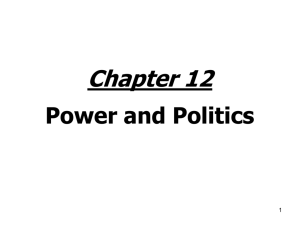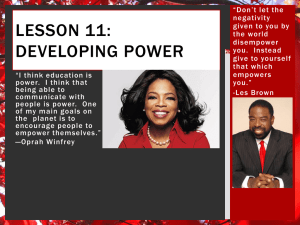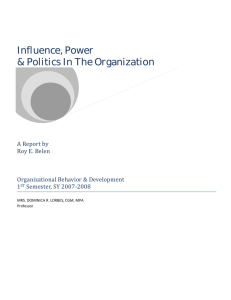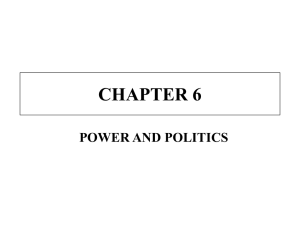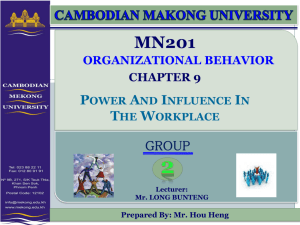Organizational Power & Politics: Presentation
advertisement
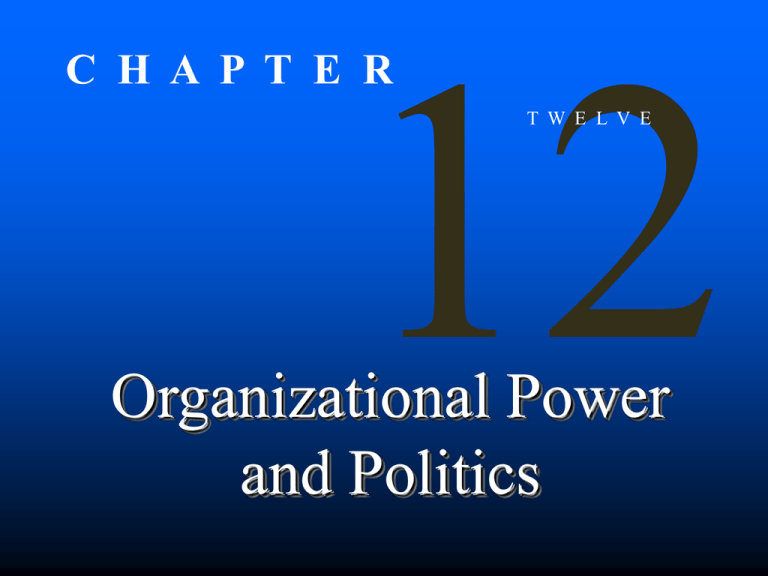
C H A P T E R T W E L V E Organizational Power and Politics Suggested topics Describe a time when you had to deal with “organizational politics”. Describe a situation where you saw evidence of power or influence being used in an organization Describe a time when someone influenced you to act a particular way or do a particular thing that you would not of otherwise done. Power Empowerment How to get it How to use it …without abusing it Definition A “four letter word”? Influence? Control over others? Being able to get things done? ?????? A shifting definition… Reflects the new “reality” of organizations A new definition of “employee” The Meaning of Power Power is the capacity of a person, team, or organization to influence others. – The potential to influence others – People have power they don’t use and may not know they possess – Power requires one person’s perception of dependence on another person Southland Times, New Zealand Why does having power matter? With power you can… Intercede favorably on behalf of someone in trouble Get a desirable placement for a talented subordinate Get approval for expenditures beyond the budget Get items on and off agendas Get fast access to decision makers Maintain regular, frequent contact with decision makers Acquire early information about decisions and policy shifts The goal? Overcome feelings of powerlessness Convert power effectively into interpersonal influences in ways that avoid the abuse of power To empower yourself To facilitate the empowerment of others Relationship Among Social Influence, Power, and Politics Capacity to exert influence Organizational politics Use of power for personal interests Power Successful Social influence Unsuccessful Power and Dependence Person B’s counterpowe r over Person A Person B Person A Person A’s power over Person B Person B’s Goals Types of Individual Power: A Summary Individual Power Position Power • Legitimate power • Reward power • Coercive power Personal Power • Referent power • Expert power Model of Power in Organizations Sources Of Power Legitimate Reward Coercive Expert Referent Power over Others Contingencies Of Power Legitimate Power One’s structural position The power a person receives as a result of his or her position in the formal hierarchy of an organization The Limits of Legitimate Power The Caine Mutiny illustrates the limits of legitimate power in organizations. Captain Queeg (Humphrey Bogart, seated left) asked his crew to do more than they were willing to follow, so they staged a mutiny. Archive Photos Reward and Coercive Power Power that achieves compliance based on the ability to distribute rewards that others view as valuable Coercive Power: the opposite of reward power: the power that is based on fear of negative results. Sources of Power Legitimate Power Reward Power Coercive Power Expert Power Archive Photos Referent Power Expert Power Influence is based on special skills or knowledge Referent Power Influence is based on possession by an individual of desirable resources or personal traits The desire to please… Information and Power Control over information flow – Based on legitimate power – Relates to formal communication network – Common in centralized structures (wheel pattern) Coping with uncertainty – Those who know how to cope with organizational uncertainties gain power » Prevention » Forecasting » Absorption Contingencies of Power Sources Of Power Power over others Contingencies Of Power Substitutability Centrality Discretion Visibility Increasing Nonsubstitutability Differentiation Controlling Tasks Increasing Nonsubstitutability Controlling Labour Controlling Knowledge Consequences of Power Sources of Power Consequences of Power Expert Power Referent Power Legitimate Power Commitment Compliance Reward Power Coercive Power Resistance Sexual Harassment and Power Harasser stereotypes the victim as subservient and powerless Harasser threatens job security or safety through coercive or legitimate power Hostile work environment harassment continues when the victim lacks power to stop the behaviour Office Romance and Power Co-workers believe that employees in relationships abuse their power to favour each other. Higher risk of sexual harassment when relationship breaks off. Organizational Politics Attempts to influence others using discretionary behaviours to promote personal objectives – Discretionary behaviours — neither explicitly prescribed nor prohibited Politics may be good or bad for the organization Extent to Which Political Activity is Likely (range 0-3) Organizational Politics: More Likely at the Top (1.22) Political activity is perceived to increase at higher organizational levels 1.3 1.2 1.1 (1.07) 1.0 .9 (.73) .8 .7 .6 (.50) (.54) .5 .4 .3 (.18) .2 .1 Production and Clerical and Technical and Lower Middle Upper blue collar white collar professional management management management Organizational Level Types of Organizational Politics Managing impressions Creating obligations Attacking and blaming Types of Organizational Politics Cultivating networks Controlling information Forming coalitions Impression management Conformity: agreeing with another’s opinion to get their approval Excuses: Explanations of a predicament-creating event aimed at minimizing the apparent severity of the predicament Apologies: Admitting responsibility for an undesirable event and simultaneously seeking to get a pardon for the action Acclamations: Explanation of favourable events to maximize the desirable implications for oneself. Flattery: Complimenting others on their virtues in an effort to make oneself appear perceptive and likeable Favours: Doing something nice for someone to gain that person’s approval Association: Enhancing or protecting one’s image by managing information about people and things with which one is associated. It was John’s fault You scratch my back… Attacking and blaming I thought you knew… Creating obligations Types of Organizational Politics Cultivating networks Look who I know… Controlling information Forming coalitions We agreed that… Conditions for Organizational Politics Personal Characteristics Scarce Resources Conditions Supporting Organizational Politics Tolerance of Politics Complex and Ambiguous Decisions Conditions for Organizational Internal Politics Perceived locus of alternatives? control Personal Characteristics Deceit is appropriate Conditions Supporting Organizational Politics Tolerance of Politics It works here Scarce Resources Zero-sum rewards Complex and Ambiguous Decisions Democratic decision making Political Antics Top the “Most Unethical List”: Survey Results Potentially Situation Gender discrimination in recruitment or hiring Arrangements with vendors leading to personal gain Nonperformance factors used in appraisals Gender discrimination in compensation Not maintaining confidentiality Using discipline inconsistently Gender discrimination in promotion Sexual harassment Allowing differences in pay due to friendships Hiring, training, or promoting based on favouritism political behaviours (22.6) (23.1) (23.5) (25.8) (26.4) (26.9) (26.9) (28.4) (30.7) (30.7) 0 5 10 15 20 25 30 35 Percentage Responding with a 4 or 5 on a five-Point Scale Measuring Degree of Seriousness (where 5=“very great”) Controlling Political Behaviour Provide Sufficient Resources Remove Political Norms Introduce Clear Rules Hire Low-Politics Employees Free Flowing Information Increase Opportunities for Dialogue Manage Change Effectively Peer Pressure Against Politics
